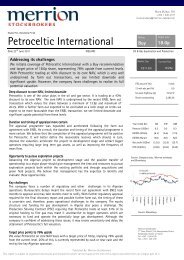Quarterly Bulletin Q3 2013
Quarterly Bulletin Q3 2013
Quarterly Bulletin Q3 2013
Create successful ePaper yourself
Turn your PDF publications into a flip-book with our unique Google optimized e-Paper software.
54<br />
Developments in the International<br />
<strong>Quarterly</strong> <strong>Bulletin</strong> 03 / July 13<br />
and Euro Area Economy<br />
Table 1: Changes in real GDP in selected economies<br />
Percentage Change<br />
2012 <strong>2013</strong> f 2014 f<br />
Global 3.0 3.1 4.0<br />
United States 2.2 1.9 2.8<br />
Euro Area -0.5 -0.6 1.1<br />
United Kingdom 0.3 0.8 1.5<br />
China 7.8 7.8 8.4<br />
Japan 2.0 1.6 1.4<br />
Source: OECD Economic Outlook no. 93 May <strong>2013</strong><br />
f Forecast<br />
United States and Japan in the absence of<br />
credible medium-term consolidation plans.<br />
There is also a risk that potential growth rates<br />
may be lower than currently estimated<br />
following the global economic crisis. Further,<br />
the outlook in the euro area and surrounding<br />
countries is dependent on fiscal policy<br />
developments as high government debt ratios<br />
could also expose countries to volatile financial<br />
market sentiment. Despite weaker-thanexpected<br />
output growth, most countries are<br />
close to stabilising their government debt-to-<br />
GDP ratios and ensuring a gradual decline in<br />
indebtedness over the longer term.<br />
Growth in many emerging countries remains<br />
buoyant but has moderated according to their<br />
first quarter GDP data releases, mainly due to<br />
local capacity constraints. Significantly, China’s<br />
growth slowed to an annualised 7.7 per cent in<br />
Q1 <strong>2013</strong> from 7.9 per cent in the final quarter<br />
of 2012.<br />
Headline inflation has generally decreased<br />
across the world over the past number of<br />
months, driven primarily by declining energy<br />
prices. OECD-measured global inflation has<br />
fallen to 1.5 per cent from 2.1 per cent a year<br />
earlier, and it is projected to stay close to this<br />
level through 2014. Consumer inflation rates of<br />
food and other goods and services have<br />
remained stable across a number of advanced<br />
economies. Among developing and emerging<br />
economies, inflation pressures have become<br />
more broad-based reflecting some capacity<br />
constraints and an increasing weight of nonfood<br />
commodities in consumption baskets.<br />
Monetary policy tightening has started in some<br />
65<br />
60<br />
55<br />
50<br />
45<br />
40<br />
35<br />
30<br />
25<br />
emerging economies as a result. Euro area<br />
inflation rates have remained low in recent<br />
months. Ample spare capacity together with a<br />
reduced contribution from energy prices<br />
should ensure that inflation expectations<br />
remain well-anchored.<br />
Feb<br />
Chart 1: Global Purchasing Managers’ Index<br />
Mar<br />
May<br />
Jul<br />
Sep<br />
Nov<br />
Jan<br />
Mar<br />
May<br />
Jul<br />
Sep<br />
Nov<br />
Jan<br />
Mar<br />
May<br />
Jul<br />
Sep<br />
Nov<br />
Jan<br />
Mar<br />
May<br />
Jul<br />
Sep<br />
Nov<br />
Jan<br />
Mar<br />
May<br />
Jul<br />
Sep<br />
Nov<br />
Jan<br />
Mar<br />
May<br />
2008 2009 2010 2011 2012 <strong>2013</strong><br />
Composite Output / Business Activity Index<br />
Composite New Orders / Incoming New Business Index<br />
Manufacturing New Export Orders Index<br />
Source: Markit.<br />
Note: For PMI indicators, above 50 represents expansion, below<br />
50 represents contraction.




